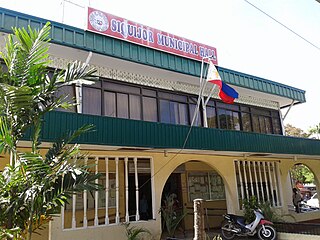
Siquijor, officially the Municipality of Siquijor, is a municipality and capital of the province of Siquijor, Philippines. According to the 2020 census, it had a population of 28,915 people making it the most populous town in the province.

La Castellana, officially the Municipality of La Castellana, is a municipality in the province of Negros Occidental, Philippines. According to the 2020 census, it has a population of 79,492 people.

Turon (Tagalog pronunciation:[tuˈɾɔn]; also known as lumpiang saging or sagimis in dialectal Tagalog, is a Philippine snack made of thinly sliced bananas, rolled in a spring roll wrapper, fried till the wrapper is crisp and coated with caramelized brown sugar. Turon can also include other fillings. Most common is jackfruit, but there are also recipes with sweet potato , mango , cheddar cheese and coconut .

Suman, or budbud, is an elongated rice cake originating in the Philippines. It is made from glutinous rice cooked in coconut milk, often wrapped in banana leaves, coconut leaves, or buli or buri palm (Corypha) leaves for steaming. It is usually eaten sprinkled with sugar or laden with latik. A widespread variant of suman uses cassava instead of glutinous rice.

A banana fritter is a fritter made by deep frying battered banana or plantain in hot cooking oil. It is a common dish across Southeast Asia and South India.

Banana cue or bananacue is a popular snack food or street food in the Philippines. It is a portmanteau of banana and barbecue, which in Philippine English refers to meat cooked in a style similar to satay.

Ginanggang, guinanggang, or ginang-gang is a snack food of grilled skewered bananas brushed with margarine and sprinkled with sugar. It originates from the island of Mindanao in the Philippines. It literally means "grilled" in Cebuano.

Pinaypay, also known as maruya, is a type of banana fritter from the Philippines. It is usually made from saba bananas. The most common variant is prepared by cutting bananas into thin slices on the sides and forming it into a fan-like shape, and coating it in batter and deep frying them. They are then sprinkled with sugar. Though not traditional, they may also be served with slices of jackfruit preserved in syrup or ice cream. Pinaypay are commonly sold as street food and food sellers at outdoor though they are also popular as home-made merienda snacks among Filipinos.

Pritong saging, also known as pritong saba, is a Filipino snack made from ripe saba or cardaba bananas sliced lengthwise and fried in oil. The bananas used are ideally very ripe, in which case it naturally caramelizes and no sugar is added. When younger starchier bananas are used, it is often eaten dipped in muscovado sugar, syrup, or coconut caramel (latik). Unlike the similar pisang goreng of neighboring countries, it is not as popular as street food. Instead it is regarded as a simple home-made snack, most commonly eaten for merienda.
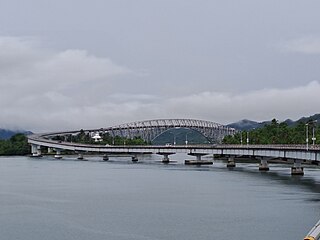
Eastern Visayas is an administrative region in the Philippines, designated as Region VIII. It consists of three main islands: Samar, Leyte, and Biliran. The region has six provinces: Biliran, Leyte, Northern Samar, Samar, Eastern Samar, Southern Leyte, one independent city, Ormoc, and one highly urbanized city, Tacloban. The highly urbanized city of Tacloban is the sole regional center. These provinces and cities occupy the easternmost islands of the Visayas group of islands, hence the region's name. Some historians believe that the oldest ancient kingdom in the Philippines is found in this region, the Lakanate of Lawan, which plays a significant role in the Polynesian and Austronesian intermigration.
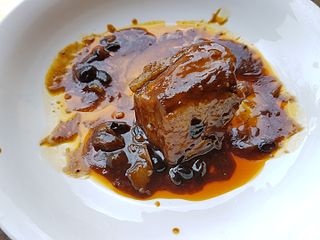
Humbà, also spelled hombà, is a Filipino braised pork dish from the Visayas, Philippines. It traditionally uses fatty cuts of pork belly slow-cooked until very tender in soy sauce, vinegar, black peppercorns, garlic, bay leaves, and fermented black beans (tausi) sweetened with muscovado sugar. It also commonly includes hard-boiled eggs and banana blossoms.

In Filipino cuisine, moron is a rice cake similar to suman. It is a native delicacy of the Waray people in the Eastern Visayas region of the Philippines, particularly in the area around Tacloban City in the province of Leyte and in Eastern Samar province. Other parts of the Philippines have their versions of it, however. In fact, the moron was adopted as one of Mambajao, Camiguin's locally produced products.
Sayongsong is a traditional Filipino steamed sweet rice cake distinctively served in cone-shaped banana leaves. It exists in Surigao del Norte and other areas of the Caraga Region of northeastern Mindanao, as well as the southeastern Visayas where it is known as sarungsong or alisuso and the Bicol Region where it is known as balisungsong. In Tagalog Regions, a similar cone-shaped rice cake is also called balisungsong, but unlike other versions, it is not sweetened and is eaten with savory dishes.

Kabkab, also known as cassava cracker or cassava crisp, is a traditional Filipino disc-shaped wafer made from ground cassava. It originates from the southern Philippines, but is most closely associated with the cuisine of Mindanao and the southern Visayas Islands.

Binagol is a Filipino sweet steamed delicacy of the Waray people made from mashed giant taro corms, condensed milk, sugar, coconut milk, and egg yolks. It is distinctively placed in half of a coconut shell and then wrapped in banana leaves and twine. The name means "placed in a coconut shell", from the Visayan bagol. Binagol traditionally uses the corms of the giant taro ; however, the corms of the taro is also alternatively used. It is a type of nilupak.
Inubaran is a Filipino chicken stew or soup made with chicken cooked with diced banana pith, coconut milk (gata) or coconut cream, a souring agent, lemongrass, and various spices. The souring agent is traditionally either batuan fruits or libas leaves. The name means "[cooked] with ubad ", not to be confused with ubod ; although ubod can sometimes be used as a substitute for ubad which can be difficult to acquire. It originates from the Western Visayas and is associated with the cuisines of the Aklanon people. Variants of the dish can also be made with other types of meat or seafood. It is a type of ginataan.
Kadyos, manok, kag ubad, commonly shortened to KMU, is a Filipino chicken soup or stew originating from the Hiligaynon people of the Western Visayas islands. The name of the dish means "pigeon peas, chicken, and banana pith"; the three main ingredients. It is similar to another Hiligayon dish, Kadyos, baboy, kag langka ("KBL"), except that it does not use a souring agent, and it uses chicken and banana pith instead. Like KBL, KMU is also characteristically purple in color due to the use of pigeon peas. Other ingredients include onions, lemongrass, thinly-sliced ginger, siling haba pepper, and salt and pepper.
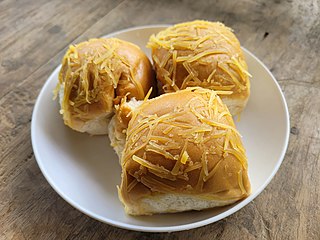
Pan de siosa, also called pan de leche, is a Filipino pull-apart bread originating from the Visayas Islands of the Philippines. They characteristically have a very soft texture and are baked stuck together. They can be eaten plain with savory meat or soup dishes, or as a dessert brushed with a generous amount of butter and sprinkled with sugar and grated cheese. In Bacolod, they can also uniquely be toasted on a skewer and brushed with oil, margarine, or banana ketchup, and then eaten paired with inihaw dishes.
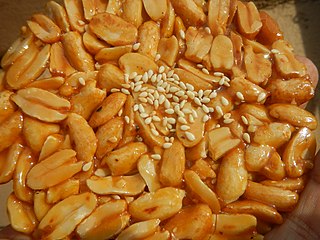
Bagkat mani, panutsang mani, panutsa, or samani is a Filipino brittle confection made with muscovado sugar or sangkaka, whole peanuts, and butter. It can also be made with whole pili nuts. It is similar to bagkat, another Filipino confection made from ground roasted or fried nuts and sugar, but the latter has a chewy texture. It is also sometimes called piñato mani, piñato de Cebu, or simply piñato in the Visayas Islands.



















